All the publicity surrounding the latest attempt at opening a new teenage nightclub in Bay City called 'Roosters' got me thinking about "the good old days" of the 1960s when the unifying force of rock and roll music was enough to draw in the kids to such clubs and thereby enable this type of business venture to be successful. By success, I mean make money. And by the end of the summer of 1964, it was clear that there was a lot of money to be made catering to the musical tastes of area teenagers
Although it technically wasn't a teenage nightclub, the inspiration for the ones that followed came from Roll-Air. Located on State Park Drive, the open-air facility became a magnet for area teenagers when the owners, Bay City educators Octavian and Christine Gavrila and Bob and Ilene Darbee, turned its 70 ft. x 206 ft. cement skating rink into a dance floor and started having Tuesday night "Battles of the Bands" during the summer of 1964.
The Gavrilas and Darbees reported to the Bay City Times that 16,000 teens had attended the eight performances over the summer that had featured twenty different bands competing for the $1,000 in prize money. The prize breakdown was: 1st place - $600, 2nd place - $250, and 3rd place - $150. Bay City's Del Raes won the first "Battle of the Bands" at Roll-Air. 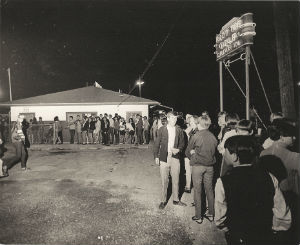 Teens lined up at Roll-Air
Teens lined up at Roll-Air
The owners' first idea had been to stage a "Hootenanny" on Tuesdays, but the arrival of The Beatles earlier in the year had put the final nails in the coffin of the folk music craze, and the idea didn't appeal to teenage Rock and Roll fans. The Gavrilas and Darbees were then contacted by WKNX deejays Bob Dyer and Dick Fabian about the possibility of running a combination dance/"Battle of The Bands" instead.
With the help of lots of on-air advertisements from Dyer and Fabian on WKNX, the "Battle of the Bands" was a sensation from the word go. Roll-Air was suddenly the Tuesday night place to be and be seen in the area. "Be there, or be square" indeed! As the crowds grew, six auxilliary policemen were hired for security and football players from the area, decked out in white shirt and ties, were employed as "bouncers". (Anyone remember college football star Wayne Meylan doing this job?) 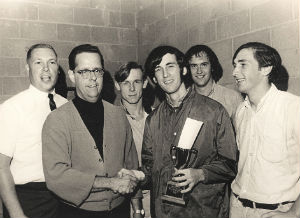 Bob Darbee and Bob Dyer with Battle of the Bands winner
Bob Darbee and Bob Dyer with Battle of the Bands winner
The kids inside would dance, talk, watch the bands, and move in a large, continuous rotation that became known as the "Roll-Air shuffle". In the second "Battle of the Bands", ? & The Mysterians finished in 3rd place. (This was about nine months before they recorded "96 Tears") The Motor City Bonnevilles finshed in first, and a Bay City band called the Mustangs finshed second in the summer of 1965.
Tuesday nights at Roll-Air later evolved into "Super Tuesdays" and other large events like the 2nd Saginaw Pop Festival that featured big-time Michigan recording artists like Bob Seger, Amboy Dukes, Rationals, Frost, Alice Cooper, MC5, and Frijid Pink. The big acts also brought bigger problems such as drug overdoses and alcohol abuse that was virtually unheard of in the summer of 1964 at Roll-Air. In the 1970s, Roll-Air became the victim of the bigger concerts and festivals that spelled the end of the first and most successful period of teen dances, teen nightclubs, and the "Battles of the Bands". 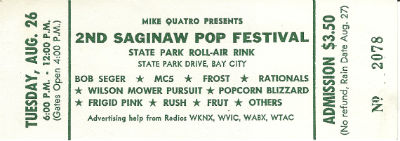
It was the success of Roll-Air in the summer of 1964, however, that eventually led to the first real teen nightclub in Bay City. The first inkling came in the February 8, 1965, edition of the Bay City Times. An article appeared that indicated that a nightclub for young adults, 16 to 21 years of age, would be built on N. Euclid Avenue near Bay City State Park in the spring. A local five-man syndicate known as Euclid Development Corporation was planning the $220,000 project.
The plans were to construct a one-story masonry building with a wood dance floor and an outdoor dancing patio. The opening was scheduled for July 1, 1965. A. J. LaMarre was the spokesman for the Euclid Development Corporation and he stated to the Times that "we feel that this is a need of the community". LaMarre pointed out that statistical studies revealed that there were 12,000 teenagers in Bay County in 1965, or 7.4% of the population, and that there were 25,000 persons ranging in age from 16 to 19 years living within a 20-mile radius.
LaMarre claimed the corporation planned to provide a nightclub atmosphere that would be restricted to young adults and that only soft drinks would be served. He also claimed that floor shows and live music would be furnished, and nationally known entertainers would be brought in periodically. Inside facilities would accommodate 1,200 people, and 2,500 could be handled by using the outdoor dancing patio. The corporation purchased a three and one half acre site for the project.
The building would have a covered entry, game room, snack bar, gossip room, and would be fully air-conditioned and carpeted. It would also have a paved and lighted parking area for 300 cars. A five-night a week operation was planned for the summer months, and the building was going to be open three nights a week during the school year. LaMarre was also planning to meet with the Bay County Youth Council to discuss his plans.
Now you might be asking yourself, who was the Bay County Youth Council? I don't know either, but I'm guessing that none of the representatives were among the 16,000 teens that attended the "Battle of the Bands" at Roll-Air the previous summer. I'm basing my hunch on the general recommendations for youth nightclubs that the council's president, Handy senior Robb Smith, released to the Bay City Times. They included these points: 1.) Activities at the nightclubs should be in cooperation with established non-profit social, educational, or religious agencies which are supported by the community, and 2.) Activities in the nightclubs should be planned so as not to conflict with religious or scholastic responsibilities of those taking part.
Yeah, those recommendations sounded like the concerns of some real "representative" teens all right. I don't know if LaMarre's meeting with the young social arbiters on the Bay County Youth Council scared him off or not, but ground was never broken on the N. Euclid teen nightclub project. 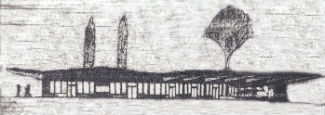 Architect's drawing of the Crystal Lounge
Architect's drawing of the Crystal Lounge
But never fear! Barely a week after the Euclid project appeared in the Times, the area's second teen nightclub was announced. Calling their proposed edifice "The Crystal Lounge", owners Aaron Eleck and his son Aaron Jr. said the structure was going to be built on an 80-acre tract on the north side of Wilder Road just west of the Consumers Power Service Center. Construction was going to start "almost immediately" with the opening expected to be May 1, 1965. The Elecks claimed that "the planning had been under way for more than a year". The facility was going to feature a modern restaurant, billiard lounge, large ballroom, outdoor dancing patio, and a carpeted, fireside gossip room. Future plans included an indoor swimming pool!
The Elecks proposed to build a one-story building, 128 ft. x 168 ft. in size of steel and masonry construction, with insulated glass dominating "to give it an all-glass look, like a jewel on the desert" the Elecks said. The plans called for a 18,000 square-foot area for dancing under the stars, and the inside ballroom big enough to accomodate 3,000 persons. Since the Elecks were building in an "open" area, they claimed that there would be no neighborhood disturbances, and it would offer "unlimited parking". The Times article also claimed that admission would be by membership ticket and that memberships were already being sold to teenagers and young adults.
Despite all the hyperbole, "The Crystal Lounge" got no farther than the artist rendering of the proposed structure that accompanied the news article. It was never reported whether or not the Elecks ever met with the Bay County Youth Council. 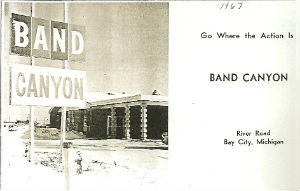
The lure of all those teenage dollars brought A. J. LaMarre back into the picture along with partners William Wesolek and Willard Kehoe. Or, most likely, they had never really left. They obtained property at 377 S. River Road, located on the southern outskirts of Bay City, and moved ahead with a plan very similar to what they had envisioned for N. Euclid.
Calling their new teen nightclub "Band Canyon", the owners even met their original goal of opening by July, 1965. The first night, however, was a Wednesday night "sneak preview" for area adults to see and enjoy the club's facilities, as well as to try to allay any fears parents might have about their teens enjoying a night filled with Rock and Roll and the opposite sex. The real opening was Friday, July 2nd from 8:30 to 12:30 and featured two shows by nationally known singing star Freddy Cannon. Cannon also appeared for two shows on Saturday, July 3rd.
Band Canyon had a sunken dance floor, surrounded by tables where teens could enjoy chips, pretzels, soft drinks, and "coketails" purchased from the snack bar. The club also had an outdoor patio for dancing under the stars in the summer, a recreation room equipped with five pool tables, and 20 pinball machines. The gossip room was covered with large floor pillows and featured tables reminiscent of off-beat coffee houses. 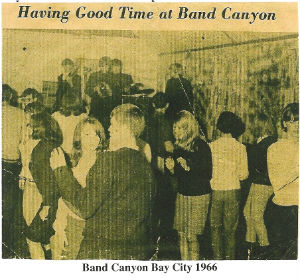
Band Canyon charged admission rather than trying to use membership cards and featured live music from different bands weekly, including early Bay City bands like the Vibrations and the Epics. Security was provided by three adults inside the club and two additional adults in the parking lot.
The club was pretty liberal in terms of dress, permitting just about anything except short-shorts. The idea was to just have a good time without causing any trouble. The vibe of the club was best expressed by the sign you saw as you left the parking lot, "Drive Carefully - Save Dad's Car".
Bands were booked on Friday and Saturday nights. Prominent Michigan bands such as The Scot Richard Case (a.k.a. SRC), The MC5, The New Bossmen (soon to be renamed The Frost), and Plain Brown Wrapper all played at Band Canyon. The few surviving band schedules for the venue also list a large number of lesser-known groups including; K.J. Knight & The Knight Riders, The Debutantes, Panic & The Paak, December's Children, The Seventh Court, The Karavans, The Classified Section, The Nomads, The Intruders, Shepherd & The Flock, The Esquires, The Poor Souls, The Sound Garden, The Chancellors, and The Talismen. 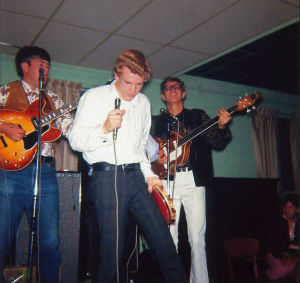 The Chancellors at Band Canyon
The Chancellors at Band Canyon
Band Canyon was Bay City's first real teen nightclub. It was successful for a few years, but by 1968 it had been sold to Richard Dicks and Robert Sajdak. The pair renamed it 'The Lady" but had limited success during their three years at the helm. By 1971 it had closed, victim to the same factors that ended Roll-Air.
Today there is very little trace of any of these once-important places. Roll-Air is now a grassy field that is part of the State Park Recreation Area. There is no sign or any indication that it was once the destination point for thousands of area teens on Tuesday nights in the summer. Former owners Bob and Ilene Darbee have a few photographs of Roll-Air and some of the winners of the "Battles of the Bands", but no one thought to write down the band names and they too have been lost to time.
The building that was once Band Canyon is now the home of Terry Rosebush Motor Sports. The business has no pictures of the once-proud teen club. Periodically, former Band Canyon regulars will come in and ask about the site, but no one at the business has much, if anything, to say about the structure's past.
This is pretty common all over, I suspect. Prime Brothers Furniture used to be the home of The Big Wheel, a pre-Band Canyon indoor roller rink that was used for teen dances and concerts. The 4 Seasons once performed there. Prime Brothers has no photos, but if you go back into the storeroom you can still find the original wood flooring. A few years back, Prime Brothers replaced their sign on the front of the building and found the original wooden sign for The Big Wheel underneath. It's still there, covered once again, thereby leaving no trace of its former glory except in the memories of those who were there. 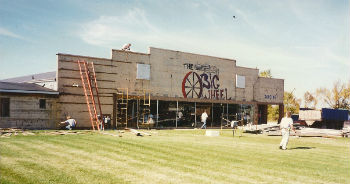 Original Big Wheel sign at Prime Brothers Furniture
Original Big Wheel sign at Prime Brothers Furniture
Now, over forty years later, we have Art Dore claiming that he opened Roosters because he "wanted a place for younger people to go" and that he "thinks there's a need for it". His teenage nightclub will have an outdoor patio, arcade games, a dance floor, deejay booth, pool tables, and a stage for local bands. They're concerned with securiity and they are going to institute a membership system for admission.
Does this remind you that old saying "the more things change, the more they stay the same"? There are also some pretty big differences, however. Admission to the club is $7, about twice as much as it cost to buy a ticket to see The Beatles perform in '64 at Olympia Stadium in Detroit. Also, they will enforce a dress code that includes no baggy pants or gang-related attire. That is not something you worried about in 1964.
The biggest difference is that Rock and Roll AM radio stations and the music they played were what really united kids in the 1960s. It was the secret way that teens communicated and found out what was going on. Everyone was listening and dancing to the same basic songs. A few of the local bands had some original songs, but most covered the hits of the day. That's why the teen nightclubs were successful then.
AM radio today has been taken over by those same forces that were trying to convince us that Rock and Roll was the "Devil's music" back in the 50's and 60's. FM radio is hopelessly formatted and deaf to any kind of local music scene. Kids communicate today via computer, cell phone, and text messaging, yet I saw that there were no provisions or accomodations for any of these things at Roosters. Most music is now downloaded in one form or another, and listened to on individual devices like iPhones or iPods.
Setting up a teenage nightclub like it was in the 60's, but without the unifying presence of commonly enjoyed music or at least the technology that connects kids today, is a project doomed to fail. I hope I'm wrong, but I don't see Roosters lasting to the first of the year.
Aftyerword: Roosters teen night club, located on Midland St. on Bay City's West Side, was a dismal failure and closed after operating for less than two weeks.

